
Mir Qamar-ud-din Khan Siddiqi also known as Chin Qilich Qamaruddin Khan, Nizam-ul-Mulk, Asaf Jah and Nizam I, was the first Nizam of Hyderabad. He was married to the daughter of a Syed nobleman of Gulbarga. He began his career as a favourite of the Mughal emperor Aurangzeb, who made him a general. Following the death of Aurangzeb in 1707, Asaf Jah refused to favour any one of Aurangzeb's warring sons and as such remained neutral. When Aurangzeb's third son Bahadur Shah ultimately emerged victorious, Asaf Jah was rotated as governor of multiple Mughal provinces until 1714, when he was created Viceroy of the Deccan with authority over six Mughal provinces in southern India from 1714 to 1719. From 1719 onwards he was involved in combating the intrigues of the Sayyid Brothers. From 1720 to 1722 he helped the new Mughal emperor Muhammad Shah eliminate the Sayyed brothers and was rewarded by being elevated to the grand viziership from 1722 to 1724. He also engaged in military conflict against Bajirao I in Battle of Palkhed and Battle of Bhopal.

Nizam of Hyderabad was the title of the ruler of Hyderabad State. Nizam is a shortened form of Niẓām ul-Mulk, which means Administrator of the Realm, and was the title bestowed upon Asaf Jah I when he was appointed Viceroy of the Deccan by the Mughal Emperor Farrukhsiyar. In addition to being the Mughal Viceroy (Naib) of the Deccan, Asaf Jah I was also the premier courtier of the Mughal Empire until 1724, when he established the independent monarchy of Hyderabad and adopted the title "Nizam of Hyderabad".

Mirza Aziz-ud-Din Muhammad, better known by his regnal name Alamgir II, was the fifteenth Mughal emperor from 1754 to 1759. He was the son of Jahandar Shah.

Ahmad Shah Bahadur, also known as Mirza Ahmad Shah or Mujahid-ud-Din Ahmad Shah Ghazi, was the fourteenth Mughal emperor, born to Emperor Muhammad Shah. He succeeded his father to the throne in 1748, at the age of 22. When Ahmed Shah Bahadur came to power, the Mughal Empire started to decline. Furthermore, his administrative weakness eventually led to the rise of the usurping Imad-ul-Mulk.

Asaf Jah VI, also known as Sir Mir Mahboob Ali Khan Siddiqi Bayafandi, was the 6th Nizam of Hyderabad. He ruled Hyderabad State, one of the princely states of India, between 1869 and 1911.

Paigah family was a noble family from the former Hyderabad State. The family maintained their own court, individual palaces, and a standing army of about fourteen thousand infantry and cavalry troops.

The Carnatic wars were a series of military conflicts in the middle of the 18th century in India's coastal Carnatic region, a dependency of Hyderabad State, India. The first Carnatic wars were fought between 1740 and 1748

Mir Farqunda Ali Khan commonly known as Nasir-ud-Daulah, was Nizam of Hyderabad, a princely state of British India, from 24 May 1829 until his death in 1857.
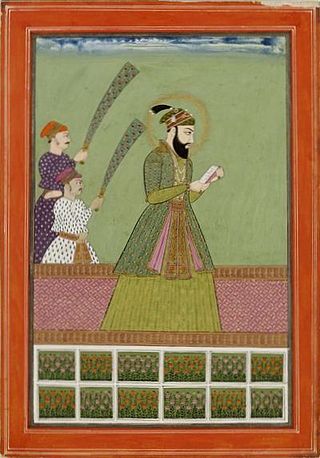
Mir Ahmad Ali Khan Siddiqi Bayafandi, Nasir Jung, was the son of Nizam-ul-Mulk by his wife Saeed-un-nisa Begum. He was born 26 February 1712. He succeeded his father as the Nizam of Hyderabad State in 1748. He had taken up a title of Humayun Jah, Nizam ud-Daula, Nawab Mir Ahmad Ali Khan Siddiqi Bahadur, Nasir Jung, Nawab Subadar of the Deccan. However, he is most famously known as Nasir Jung.
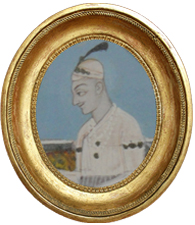
Salabat Jung, born as Mir Sa'id Muhammad Khan Siddiqi Bayafandi on 24 November 1718, was the 3rd son of Nizam-ul-Mulk. He was appointed as Naib Subahdar to his elder brother, Ghazi ud-Din Khan Feroze Jung II, the Prime Minister of Mughal Empire, with the title Salabat Jung. He was invested by Imperial firman, at Aurangabad, Maharashtra, 12 September 1749. He was granted the titles of Khan Bahadur and Salabat Jung during his father's lifetime.
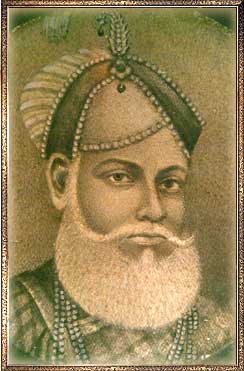
Anwaruddin Khan, also known as Muhammad Anwaruddin, was the 1st Nawab of Arcot. He belonged to a family of Qannauji Sheikhs. He was a major figure during the first two Carnatic Wars. He was also Subedar of Thatta from 1721-1733.
Nawab Muhammad Taqi Khan Bahadur was Nawab of Masulipatam. He attacked Sisupalgarh town in 1731.
Muhammad Beg Khan-e Rosebahani was Qiladar and Jagirdar of Banganapalle. He was a supposed uncle of Imad ul-Mulk, Nawab Khwaja Muhammad Mubariz Khan Bahadur, Hizbar Jang, sometime Subadar of the Deccan and Wazir. In 1665, he was appointed as Qiladar of Banganapalle Fort and granted the surrounding districts in jagir by the Sultan of Bijapur. He died in 1686.

The Asaf Jahi was a Muslim dynasty that ruled the Hyderabad State. The family came to India in the late 17th century and became employees of the Mughal Empire. They were great patrons of Persian culture, language, and literature, and the family found ready patronage.

The siege of Trichinopoly was part of an extended series of conflicts between the Nizam of Hyderabad and the Maratha Empire for control of the Carnatic region. On 29 August 1743, after a six-month siege, Murari Rao surrendered, giving Nizam ul Mulk (Nizam) the suzerainty of Trichinopoly. By the end of 1743, the Nizam had regained full control of Deccan. This stopped the Maratha interference in the region and ended their hegemony over the Carnatic. The Nizam resolved the internal conflicts among the regional hereditary nobles (Nawabs) for the seat of governor (Subedar) of Arcot State, and monitored the activities of the British East India company and French East India Company by limiting their access to ports and trading.
Intizam-ud-Daula, Ghazi ud-Din Khan Siddiqi Bayafandi Feroze Jung II was the eldest son of Asaf Jah I Mir Qamaruddin Khan Siddiqi. He was born on 13 March 1709, his mother is Sa'id un-Nisa Begum, the daughter of a Sayyid nobleman at Gulbarga. He died in Aurangabad on 16 October 1752.

The Battle of Ambur was the first major battle of the Second Carnatic War.

The Battle of Shakar Kheda took place on 11 October 1724 at (Fathekheda) in Berar and 350 kilometres from Aurangabad between Nizam-ul-Mulk and Mubariz Khan, Subedar of the Deccan.
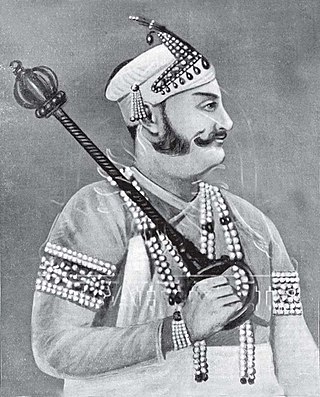
Shams ul-Umara, Shams ul-Mulk, Shams ud-Daula, Nawab Muhammad' Abu’l Fath Khan Bahadur, Taigh Jang Bahadur ['Abu’l Khair Khan II] [Imam JungIII] was an Indian nobleman and founder of the House of Paigah.
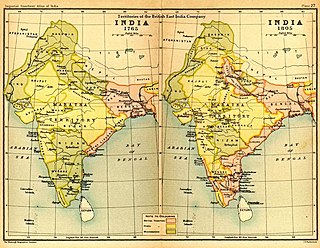
The Maratha-Nizam War (1720–1819) was a series of military conflicts between the Maratha Empire and the Nizam of Hyderabad, spanning nearly a century. These conflicts arose primarily from the Marathas' imposition of Chauth, a form of tribute, on the Nizam's dominions, leading to tensions and subsequent hostilities between the two powers. The Nizam's response to the Maratha demands sparked a series of clashes and wars aimed at resisting Maratha encroachment and asserting territorial sovereignty.


















